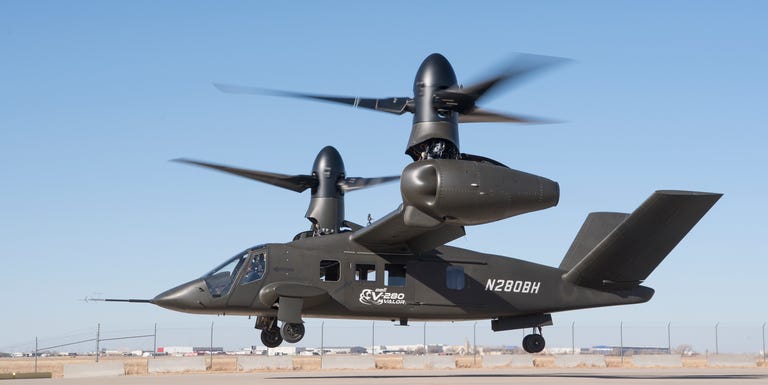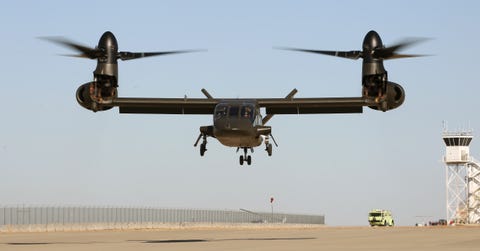Bell's New V-280 Tiltrotor Achieves First Flight
The first tiltrotor in three decades finally takes to the air.

BELL HELICOPTER
By Kyle Mizokami
A contender to replace the UH-60 Black Hawk in U.S. military service just achieved first flight. The V-280 Valor tiltrotor lifted off the ground and briefly hovered, the first in a long and rigorous testing schedule. The V-280 uses new tiltrotor technology and will fly farther and faster than conventional helicopters it was designed to replace.
The UH-60 Black Hawk helicopter is the U.S. Army’s standard medium lift helicopter. The latest version, the UH-60M has a cruising speed of 151 knots, a combat range of 368 miles, and can carry up to twelve troops or a 9,000-pound slung load. While that’s impressive, the Black Hawk design was introduced in the early 1980s and cannot take advantage of all the new technological developments in vertical flight that have come about in the last 35 years.
The Pentagon’s long term plan is to replace all military helicopters with the Future Vertical Lift (FVL). The effort to replace the Black Hawk and Apache helicopters is known as Future Vertical Lift - Medium, and there will be at least five FVL aircraft and at least three different airframes. FVL aircraft will use leap-ahead propulsion technology, replacing everything from the OH-58 Kiowa scout helicopter to the CH-47 Chinook heavy lift helicopter.
FVL-M is the first aircraft the Army—the service leading the effort—will tackle, and the V-280 Valor is Bell helicopter’s entry in the program. Bell, which already makes the V-22 Osprey, is going with a tiltrotor design. The design will allow the Valor to take off like a helicopter and then rotate its propellers ninety degrees to function as a conventional propeller-driven aircraft.
The V-280 promises dramatic improvements in how the U.S. Army moves troops by air. According to Bell, the V-280 will do 280 knots, making it almost twice as fast as the UH-60M. It will also have a combat range of 500 to 800 miles, the latter more than double the Black Hawk’s range. Lastly, the V-280 will have a crew of 4 and can carry 14 passengers, while the UH-60 has a crew of 3 and can carry a maximum of 12.

V-280 Valor during first flight.
BELL HELICOPTER.
The V-280 looks like the love child of a Black Hawk and Osprey. The aircraft’s fuselage and nose look like a Black Hawk, with the large T-shaped wing and oversized rotors of the Osprey. One key manner in which the Valor differs from the Osprey: while the Osprey rotates the entire wingtip, including engine ninety degrees to shift between flight modes, the Valor just rotates the rotors themselves. In fact, Bell is being kind of secretive about exactly how the Valor rotates its rotors—as you can see in the video, it blurs out the complex mass of machinery visible when the aircraft is in hover mode.
The FVL-M program will see the V-280 Valor will compete against the Boeing-Sikorsky SB>1 Defiant, which uses a combination contra-rotating main rotor with a push propeller to achieve breakthrough speeds. The winning aircraft will likely replace not only the UH-60 Black Hawk but also the AH-64 Apache.
No comments:
Post a Comment